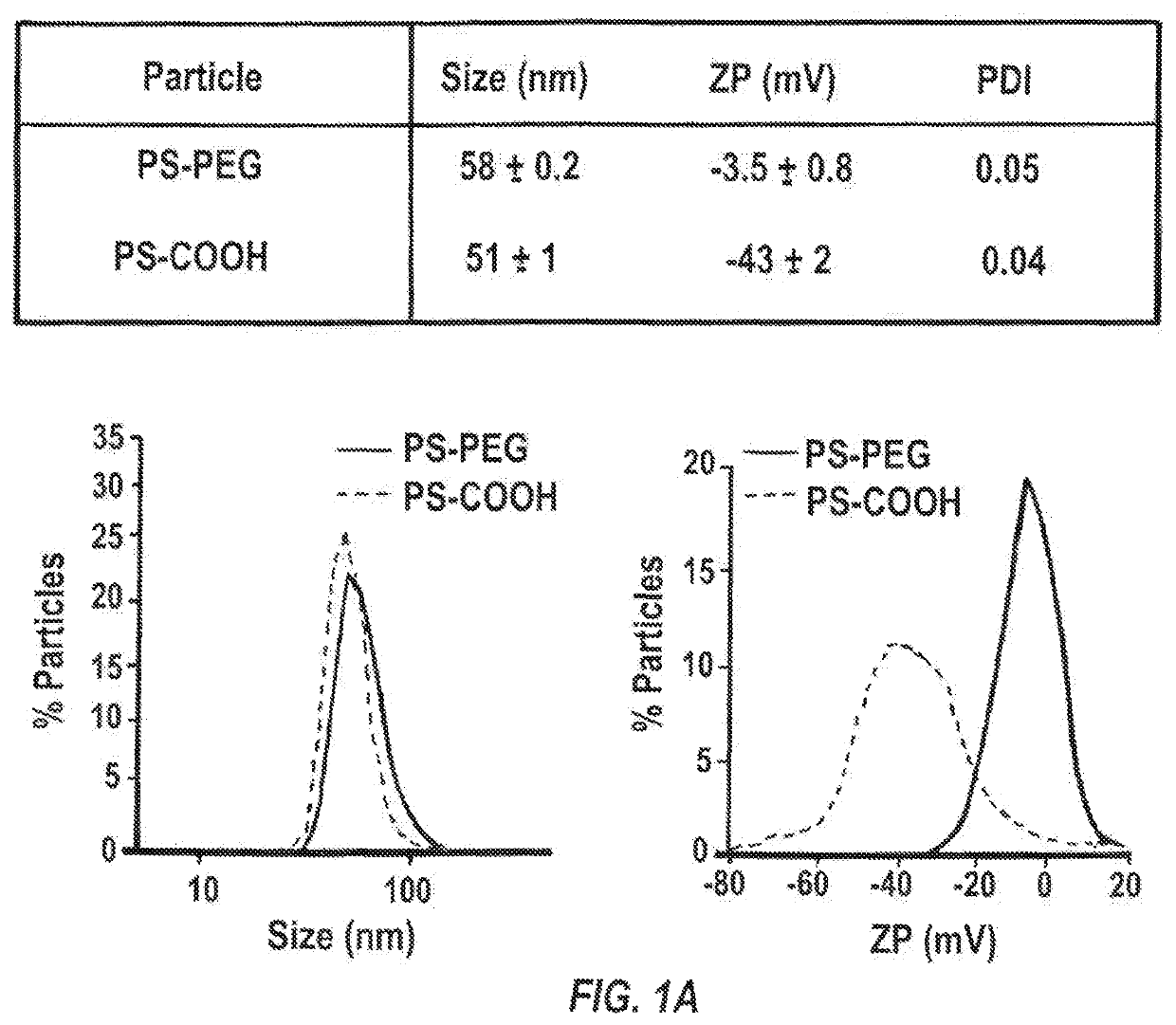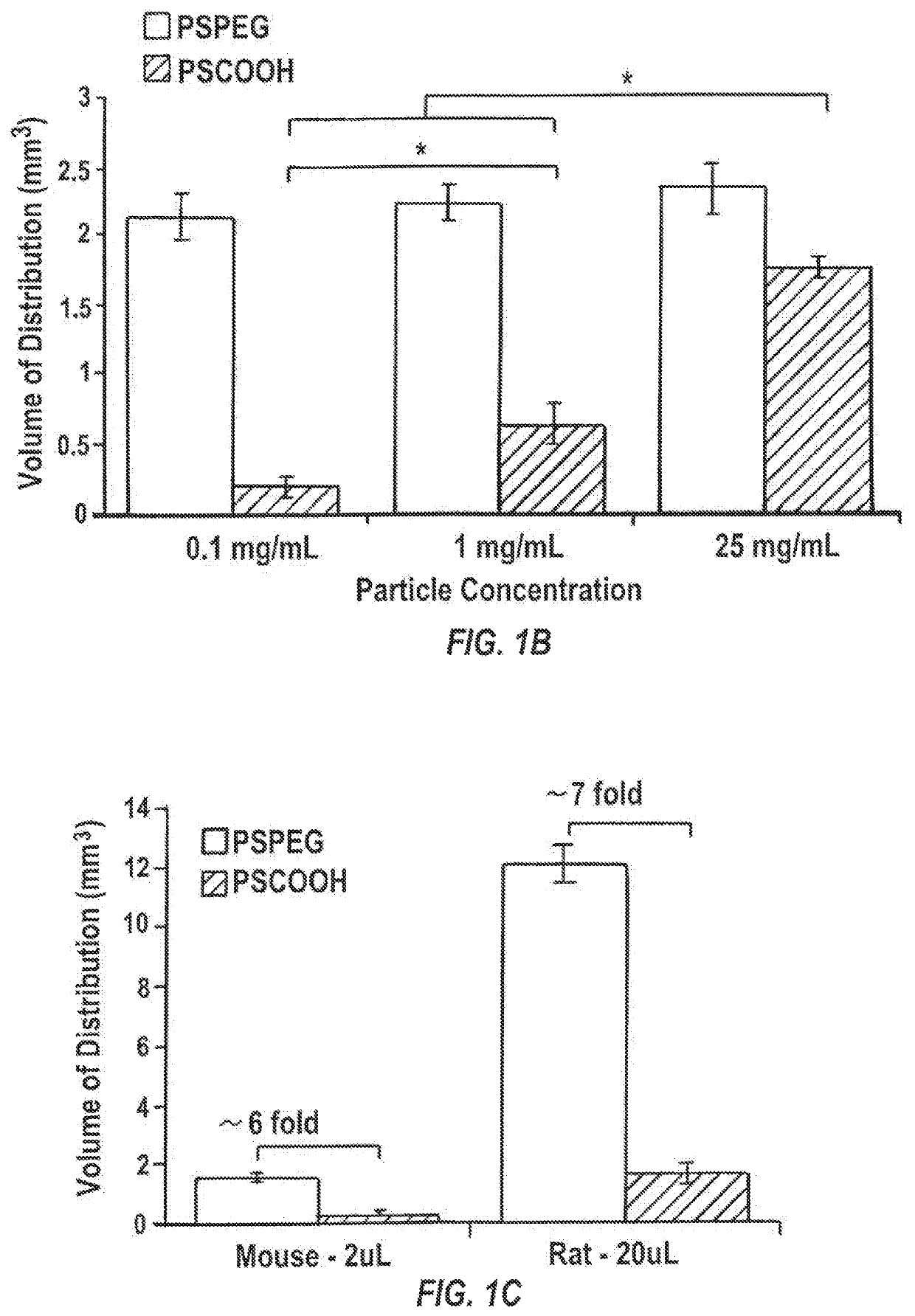Compositions and methods to improve nanoparticle distribution within the brain interstitium
a brain interstitium and nanoparticle technology, applied in the direction of drug compositions, microcapsules, inorganic non-active ingredients, etc., can solve the problems of reducing the ability of nanoparticles to reach the target cells, unable to achieve therapeutically favorable distribution, etc., to reduce the adhesion of nanoparticles, improve and enhance the distribution of nanoparticles
- Summary
- Abstract
- Description
- Claims
- Application Information
AI Technical Summary
Benefits of technology
Problems solved by technology
Method used
Image
Examples
example 1
f Coating Particles with Non-adhesive Coating
[0141]Materials and Methods
[0142]i. Nanoparticle Preparation and Characterization
[0143]40-nm dark red fluorescent carboxylated polystyrene microspheres (PS-COOH) (Life Technologies, Grand Island, N.Y.) were modified by conjugating a dense layer of 5 kDa methoxy-PEG-amine (Creative PEGworks, Winston Salem, N.C.), onto the surface, according to a previously published protocol (Nance, E. A., et al., Sci Transl Med, 2012, 4(149), 149ra119), to obtain densely PEGylated polystyrene nanoparticles (PS-PEG). PLGA (75:25) (MW: 15 kDa; Jinan Daigang Biomaterials Co. Ltd., Jinan, China) and PLGA-PEG (75:25) (25 wt % PEG; Jinan Daigang Biomaterials Co. Ltd., Jinan, China) nanoparticles were formulated using the single emulsion process according to a previously published protocol (Nance, E., et al., ACS Nano, 2014, 8(10), 10655-10664). Briefly, PLGA-PEG and PLGA polymer were fluorescently labeled with AlexFluor 647 and AlexaFluor 555 cadaverine dye (Mo...
example 2
f Different Concentrations of Infusate Composition
[0159]Materials and Methods
[0160]i. Ex Vivo Characterization of Brain Pore Sizes
[0161]Brains from female CF-1 mice were harvested and multiple particle tracking was conducted on nanoparticles injected into 1.5 mm thick brain slices according to a slightly modified protocol of Nance, et al., Sci Transl Med, 2012, 4(149), 149ra119. Briefly, the harvested rodent brain was rinsed in chilled artificial spinal fluid and sliced at 1.5 mm intervals using a Zivic mouse brain mold (Zivic Instruments, Pittsburgh, Pa.). Individual brain slices were immersed in infusate solutions (water, 0.9% saline, 3% saline, 10% mannitol, or 25% mannitol) for 5 minutes. Brain slices were removed and mounted on a custom made well and 0.5 μL of fluorescently labeled PS-PEG nanoparticles were injected into the cortex. A coverslip was glued on top of the specimen to prevent bulk flow in the tissue. The particle trajectories were recorded as 20 second movies at an ...
PUM
| Property | Measurement | Unit |
|---|---|---|
| diameter | aaaaa | aaaaa |
| diameter | aaaaa | aaaaa |
| diameter | aaaaa | aaaaa |
Abstract
Description
Claims
Application Information
 Login to View More
Login to View More - R&D
- Intellectual Property
- Life Sciences
- Materials
- Tech Scout
- Unparalleled Data Quality
- Higher Quality Content
- 60% Fewer Hallucinations
Browse by: Latest US Patents, China's latest patents, Technical Efficacy Thesaurus, Application Domain, Technology Topic, Popular Technical Reports.
© 2025 PatSnap. All rights reserved.Legal|Privacy policy|Modern Slavery Act Transparency Statement|Sitemap|About US| Contact US: help@patsnap.com



